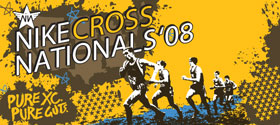 |
 |
 |
|
|
 |
 |
 |


| NXN Finals
12/6/08 - Portland Meadows, Portland OR
|
About those at large bids
how Nike's good intentions led to unintended consequences
by John Dye
12/4/08 -- Have you been wondering why:
- Carmel IN, with the 10th ranked girls team in the nation and 12th ranked boys team (in Marc Bloom's Harrier magazine Super 25 national rankings), will be missing in Portland OR Saturday at the Nike Cross Nationals finals?
- The South region, with only one nationally ranked girls team, has four girls teams in the 22-team finals?
This is a story of good intentions and unintended consequences.
When Nike Cross Nationals (nee Nike Team Nationals) started in 2004, there were no regional meets. All teams were selected by a committee. Naturally, there were criticisms of regional bias and other subjective influences, especially from teams not selected.
The fourth NTN in 2007 introduced regional meets. Now, the pendulum swung all the way to the objective side. All selections would be settled on the course. The top 2 finishers in eight regional meets would qualify for the national finals. The ninth region, California, would get two auto qualifiers from a power merge of the 20 top teams in the California state meet.
Because some regions are stronger and deeper than others, four national at large bids would be awarded, with all regional 3rd and 4th place finishers eligible. The at large bids would be based on a strict set of rules, with the primary factor being points for in-season wins over teams already qualified. The four teams with the most points would win a slot in national finals.
The objective was "to identify the four best remaining teams in the country" after auto qualifiers were identified. Nike said the system was modeled after the NCAA system of choosing at large teams for the Division I national cross country championships.
Flaws in the system
Several flaws became evident this year.
- Unlike college cross country, high school has no series of invitationals and a pre-national meet with many opportunities to face contending teams and accumulate points.
- With advent of regionals, there was less incentive to travel out of region to meet strong teams and influence the rankers -- you could just wait for regionals and finish top 2.
- Some schools can't travel because of state association or local rules.
- Some regions have concentrations of teams that face each other all year; other regions are scattered and contending teams from different states do not meet until the regional.
- It is easier to get points in balanced regions than in regions dominated by powerhouses.
- Points in weak region have same value as a strong region.
So what caused problems this year?
- In the Northeast regional, the Danbury CT boys finished 4th, but had a lot of points and qualified for an at large slot. Due to another rule, Northeast 3rd place North Allegheny PA, with no points and unranked nationally, was pushed into nationals by Danbury.
- In the South region, Texas teams dominate and face each other many times during the year, often trading wins. In the girls regional meet, Kingwood Park and Vista Ridge finished 3rd and 4th. They were unranked nationally, and Vista Ridge was not even ranked in the region, but both teams were awarded an at large bid to national finals because they had enough at large points.
- Carmel IN, a close third in the Midwest behind strong teams (4 points in boys race, 7 points in girls), was left out. Carmel appealed, but since at large bids were awarded according to the established rules, there was no basis to let them in. Thus a storybook season under retiring coach Chuck Koeppen -- both boys and girls teams won the Indiana state championship -- ended on a sour note.
In his appeal to Nike, Coach Koeppen said the at large point system is flawed.
"I think it is clear that this new system has not met the stated intent of Nike's primary objective (identifying the four best remaining teams in the country). I commend Nike for seeking a system that takes selection away from any committee back room politics or subjective rankings. The organizers obviously care about this tournament and its future. However, this current system has been disappointing and I hope it can be improved upon in the next year."
Improvements will be made
Nike's Josh Rowe, one of the founders of the meet, said improvements will be made.
"We always review our system at the end of each year to see what worked well and what didn't. This year exposed some problems we didn't have before. We will make adjustments to make the event better and move closer to the goal of having the best teams in the country in the national finals."
Due to the accuracy of the season-long regional rankings (31 of 36 auto qualifiers were ranked first or second in their regions before the regionals), Nike will probably rely more on expert analysis and less on rules for at large bids next year. Some of the same factors as in the rule-based system will be considered, but judgment will be added back to the mix.
See you next year -- same time, same place -- to see how it all works out in NXN 6.
Links:
Disclosure: John Dye was on the NTN rankings committee from 2004 to 2007 but not this year. DyeStatCal editor Rich Gonzalez has been on the rankings committee since inception.
|
|
|
|
|
 |
 |